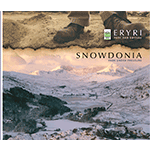View PDF version Download PDF file
PDF requires Adobe Acrobat Reader.
Available to download for free here
A guide to the uplands for hillwalkers and climbers
The revised and expanded 2nd Edition of the first complete field guide for the mountains of Snowdonia through the seasons, its plants, animals and rocks. Everything you’re likely to see in the hills at that time of year is here in one volume.
Follow the seasons of Snowdonia; winter is the perfect time for studying rocks and lichen; in spring the bog flowers flourish and beautiful orchids bloom; summer brings fruits and flowers, and the treas are in full leaf; in autumn an amazing display of funghi appear, the hill farms are busy again in preparation for winter and as the nights draw in it is time again to sit beside the fire and tell tales of local myth and legend.
A little knowledge of thyme, tormentil and thrift will enhance your day in the hills. Fossil trilobytes and roche moutonnée (rock sheep), bogbean beer and caterpillar fungus, are just some of the fascinating things you will discover.
View PDF version Download PDF file
PDF requires Adobe Acrobat Reader.
Available to download for free here
Apologies but you have to be logged in to leave a review; we have to do this to avoid spam.

malcolmcreasey –
Nature of Snowdonia by Mike Raine.
The subtitle states this is a Beginners Guide to the Upland Environment and that is exactly what this eagerly awaited book is. Having got my hands on a copy I made the mistake of taking it home so I could have a good look through in detail. However, what in fact happened is that Caroline, my better half immediately seized on the book and I’ve only today managed to get my hands on it!
Weighing in at around 175 pages this book is lavishly illustrated with at least one, sometimes several colour photographs on each page. The book cleverly follows the seasons starting with winter setting out what lies beneath the vegetation. This first chapter is written by Dr Janet Summer who clearly has an excellent grasp of the geology of the area although she openly admits it is extremely complex and can be a little complicated to understand, particularly from a beginner’s viewpoint. However she explains this very well and although perhaps at the first reading some things might not fall into place the overall concept of what type of rock it is, where it originated from and how it got to it’s final resting place (for the time being) is easy to follow. There is an intriguing rock ‘quiz’ embedded in the first chapter with the answers given just prior to the section on glaciation which naturally enough comes next as what has happened to that rock since it arrived on the surface of the earth has played a major role in creating the landscape that we see today. After looking at what forms the bedrock to glaciation it seems natural progression to look at what plants, mosses, lichens and animals can be found living on that landscape in the winter months, a nice little progression.
To my mind this book follows a further natural progression with the 2nd chapter entitled Spring and the first subject in that chapter is of course Flowers which is also the first subject covered in the Summer chapter, however the Autumn chapter starts of with Fungi. All this feels very logical to me and the contents page makes this really easy to understand with a simple colour coding system against the chapter headings matching up to the bottom right hand corner of the pages so once you have found your way around the book, and assuming you know what season it is it should be easy peasy to find out just what you are looking at! English, Latin and Welsh names are used wherever known or possible and the information to many species contain information regarding any medicinal properties the plants were either thought or known to have. Having just a smattering of Welsh I really enjoyed this touch and hope that like me, many others who don’t have Cymraeg will perhaps understand that little bit more as a result of reading these, at the very least you can see the logic behind the names, both in English and Welsh.
Towards the end Mike finishes of with a few myths and legends before the Final Word, I’ll leave you to decide what that is! None of the subjects covered in this book are covered to any great depth and Mike freely admits that with a good bibliography at the end for those who seek to extend their knowledge. However what this book does is, and I’m going to quote my wife Caroline here with her exact words being ‘it is so nice to have a little bit of everything in one book’. Of course there can always be a few quibbles, perhaps with almost too many smaller photographs for me although the pictures do convey a clear message to the reader (or should that be viewer) and some of those captions, particularly on the multi coloured backgrounds can be difficult to read. Still, those are minor gripes for what should become a must have for anyone dipping there toes in to the Upland Environment of the Nature of Snowdonia.
Mal Creasey
Mark Rainsley –
I love this book, manages to make natural history engaging and accessible to those of who aren’t specialists, without patronising or simplifying unnecessarily. Really helps you to understand how the flora and fauna fits into the landscape around, rather than just treating it as distinct/ separate elements.